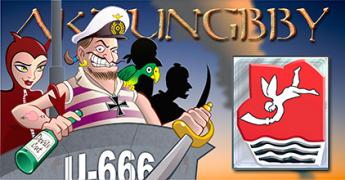 02-18-22, 12:43 AM
02-18-22, 12:43 AM
|
#20
|
|
Gefallen Engel U-666
Join Date: Jul 2013
Location: On a tilted, overheated, overpopulated spinning mudball on Collision course with Andromeda Galaxy
Posts: 27,870
Downloads: 22
Uploads: 0
|

Quote:
Originally Posted by John Pancoast

Never used a IX, have no interest in the barges or where they were used historically. Same in AOD.
North Atlantic with VIIs; that's my cup of tea.  Then onto the Inshore Campaign. |
Plus the Type VII's crash dive faster. The reason I inquired about the hard-90⁰ is that by 1943 the aircraft depth charges are set at 25', usually four to straddle crashdivers or their discernable bubble wake'. The need to divert ASAP from the path of the wake is critical in 1943.
Quote:
One of the problems the Brits researched was the “optimum trigger depth for aircraft dropped depth charges:
“…work by the CC-ORS (Coastal Command's Operational Research Section) indicated that on average, if the trigger depths of aerial-delivered depth charges were changed from 100 feet to 25 feet, kill ratios would go up. The reason was that if a U-boat saw an aircraft just before it arrived overhead, depth charges set to trigger at 100 feet would drop below the sub and do no damage because the U-boat did not have enough time to descend as far as 100 feet. On the other hand, if the crew of the U-boat spotted the attacking aircraft a long distance away, it had time to dive and alter course under the water minimizing the probability that it would be within the 20-foot kill zone of the charge when it was dropped. CC-ORS determined that it was far more efficient for anti-submarine patrol aircraft to attack U-boats only when they were close to the surface where they could be properly acquired (their locations were actually known), than to attempt their destruction at greater depths when their positions could only be guessed at.
Before the change of settings from 100 feet to 25 feet, only 1% of the submerged U-boats attacked were sunk, and only 14% were damaged. After the reducing the settings to 25 feet, 7% were sunk (a 700% increase) and 11% damaged. If submarines were sited on the surface and attacked shortly after they submerged, those percentage rose to 11% sunk (1,100% increase and 15% damaged. Peter Blackett, a noted British scientist and early supporter of Operations Research, observed "…there can be few cases where such a great operational gain had been obtained by such a small and simple change of tactics,"
|
Quote:
|
By the end of 1943, RAF Coastal Command aircraft armed with the Torpex depth charge had sunk an impressive 84 U-boats, out of 219 U-boats that were destroyed in that decisive year. 130 The 600-pound depth bomb “only accounted” for one U-boat in 1943—U-462. 139 By the end of the war, Coastal Command had dropped 97 in 28 attacks compared with 5,790 of the Torpex depth charges in 1,170 attacks. 140 The lethality of Coastal Command attacks on visible U-boats had risen to over 45 percent. 141
|
https://www.ijnhonline.org/torpex-an...antic-victory/
Quote:
|
Joubert argued that the change in depth setting from 100 to 25 feet “was probably at least as effective [as Torpex], since the “majority of attacks were made when the target was only just below the surface.”
|
__________________

"Only two things are infinite; The Universe and human squirrelyness; and I'm not too sure about the Universe"
Last edited by Aktungbby; 02-18-22 at 02:24 AM.
|

|

|